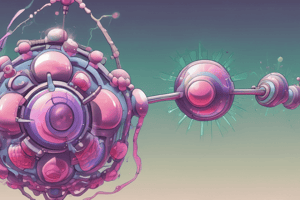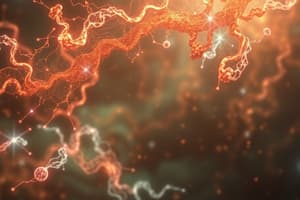Podcast
Questions and Answers
What is the function of the Activation Function 1 (AF-1) surface?
What is the function of the Activation Function 1 (AF-1) surface?
- Contains the core AF-2 domain
- Binds to a specific ligand
- Interacts with co-regulator proteins (correct)
- Forms a zinc finger DBD
Which type of receptors have a very large ligand binding pocket, allowing binding of differently sized ligands?
Which type of receptors have a very large ligand binding pocket, allowing binding of differently sized ligands?
- Unspecified monomeric receptors
- Unliganded receptors
- Homo- or heterodimers
- PPARg receptors (correct)
What is the difference in structure between liganded and unliganded receptors?
What is the difference in structure between liganded and unliganded receptors?
- Liganded structures are more compact than the unliganded ones (correct)
- Both have different levels of flexibility
- Both have similar compactness
- Unliganded structures are more compact than the liganded ones
How do most receptors bind to hormone response elements (HREs)?
How do most receptors bind to hormone response elements (HREs)?
What is the characteristic feature of ER binding?
What is the characteristic feature of ER binding?
What contributes to the specificity of binding of different steroid hormone nuclear receptors?
What contributes to the specificity of binding of different steroid hormone nuclear receptors?
What happens to the receptor after it binds the hormone?
What happens to the receptor after it binds the hormone?
Where are heterodimeric RXR NRs located under basal state?
Where are heterodimeric RXR NRs located under basal state?
What is the function of the leucine residues within the hydrophobic groove of the AF-2 surface?
What is the function of the leucine residues within the hydrophobic groove of the AF-2 surface?
Which motif is contained in the corepressors such as NCoR and interacts at the same hydrophobic AF2 surface with H12 in a different position?
Which motif is contained in the corepressors such as NCoR and interacts at the same hydrophobic AF2 surface with H12 in a different position?
What is the result of ligand (agonist) binding to RXR heterodimers?
What is the result of ligand (agonist) binding to RXR heterodimers?
What is the function of CBP/p300 in the context of histone modification?
What is the function of CBP/p300 in the context of histone modification?
What is the characteristic feature of steroid receptors when binding palindromic HSE?
What is the characteristic feature of steroid receptors when binding palindromic HSE?
What contributes to the specificity of binding of different Steroid hormone NRs?
What contributes to the specificity of binding of different Steroid hormone NRs?
What leads to the induction of nuclear transport for GR?
What leads to the induction of nuclear transport for GR?
Where are homodimeric NRs located under basal state?
Where are homodimeric NRs located under basal state?
What is the role of heat shock proteins (HSP) in regulating steroid receptors?
What is the role of heat shock proteins (HSP) in regulating steroid receptors?
What prevents heterodimeric RXR NRs from being active in the basal state?
What prevents heterodimeric RXR NRs from being active in the basal state?
What is the common basic structure shared by steroid hormones?
What is the common basic structure shared by steroid hormones?
What is the function of the peptide loop in the DNA binding Dimer formation region?
What is the function of the peptide loop in the DNA binding Dimer formation region?
Where are C-terminal extensions (CTEs) found in some nuclear receptors like LRH-1 and GCNF located?
Where are C-terminal extensions (CTEs) found in some nuclear receptors like LRH-1 and GCNF located?
In which part of the polypeptide chain are the highly conserved DNA-binding domains located?
In which part of the polypeptide chain are the highly conserved DNA-binding domains located?
What is the role of the second subdomain helix in the DNA binding process?
What is the role of the second subdomain helix in the DNA binding process?
What type of contacts do some nuclear receptors, like LRH-1 and GCNF, make with the minor groove of the DNA?
What type of contacts do some nuclear receptors, like LRH-1 and GCNF, make with the minor groove of the DNA?
Which residues on genomic response elements do the first subdomain residues of NR DBDs interact with?
Which residues on genomic response elements do the first subdomain residues of NR DBDs interact with?
What is represented as spheres in the Cartoon representation of folded GR DBD highlighting NR?
What is represented as spheres in the Cartoon representation of folded GR DBD highlighting NR?
What is the structure of the ligand-binding domain (LBD) mainly composed of?
What is the structure of the ligand-binding domain (LBD) mainly composed of?
Which nuclear receptor contains an extra helix designed H29 in its overall structure?
Which nuclear receptor contains an extra helix designed H29 in its overall structure?
What is the poorly structured insertion between helices H1 and H3 found in the VDR?
What is the poorly structured insertion between helices H1 and H3 found in the VDR?
In which region of the LBD are the ligand-binding pockets located?
In which region of the LBD are the ligand-binding pockets located?
What are the contacts with the ligand within the LBD described as?
What are the contacts with the ligand within the LBD described as?
Which receptor has a very large ligand binding pocket, allowing binding of differently sized ligands?
Which receptor has a very large ligand binding pocket, allowing binding of differently sized ligands?
What is a characteristic difference between liganded and unliganded structures of receptors?
What is a characteristic difference between liganded and unliganded structures of receptors?
What is mainly hydrophobic and buried within the bottom half of the LBD?
What is mainly hydrophobic and buried within the bottom half of the LBD?
Which element creates a cavity, the ligand-binding pocket, within the LBD?
Which element creates a cavity, the ligand-binding pocket, within the LBD?
Flashcards are hidden until you start studying




